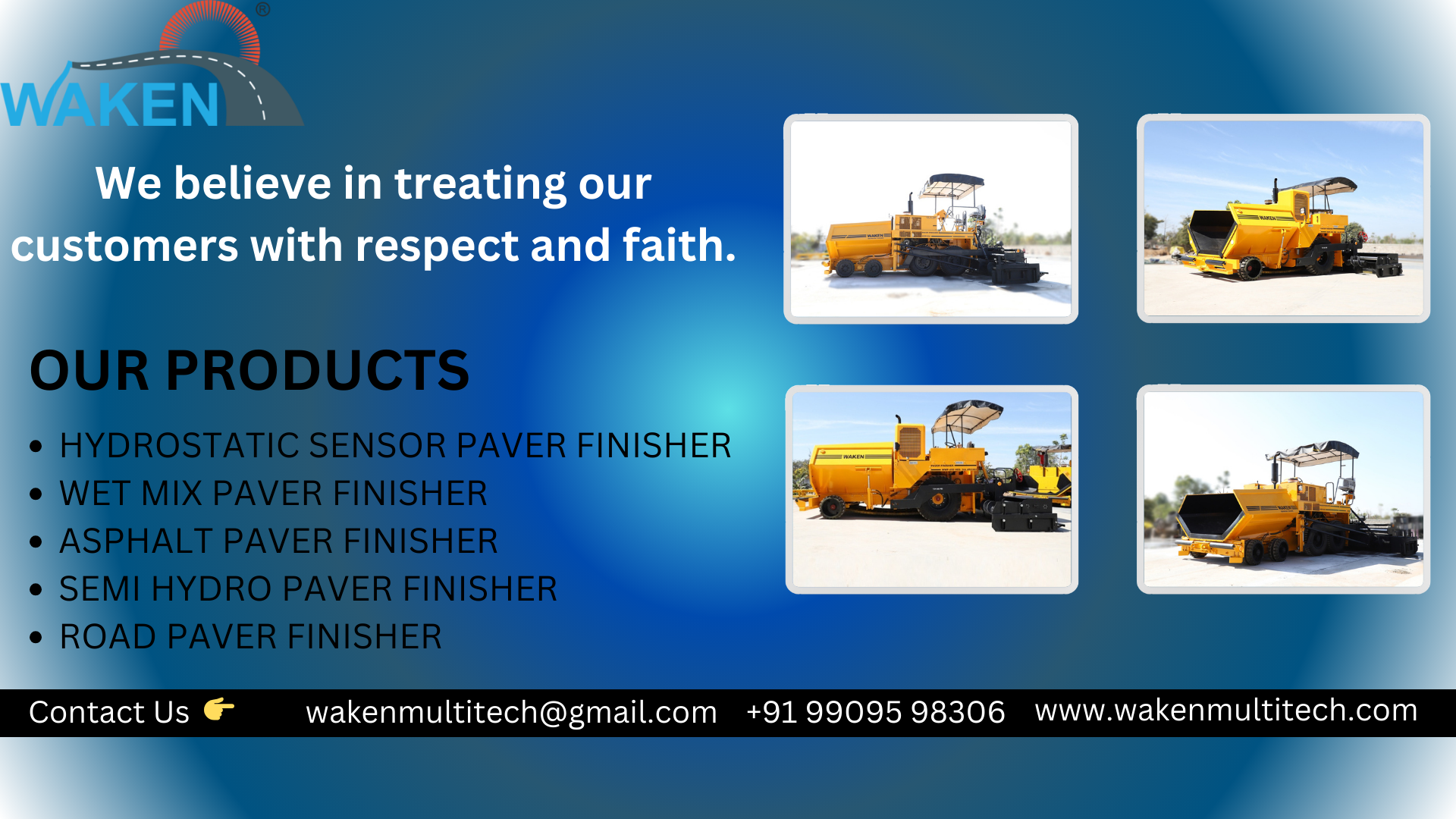Introduction to Mechanical Paver With Hydraulic Conveyor Drive
Mechanical Paver With Hydraulic Conveyor Drive delivers consistent mat quality for national highways, city roads, and industrial estates across India. A robust mechanical screed ensures uniform compaction, while the hydraulic conveyor and augers feed hot mix evenly at variable speeds. Operators benefit from responsive controls, fuel-efficient power, and quick setup that reduces paving downtime. Designed for Indian ambient conditions and aggregates, the paver handles dense bituminous macadam, stone mastic asphalt, and wet mix macadam with ease. For buyers comparing options, explore specifications and service capabilities on this highway construction equipment portal. The result is smoother rides, predictable productivity, and lower lifecycle cost.
Working Principle and Process Flow of Mechanical Paver With Hydraulic Conveyor Drive
After preheating and calibration, aggregate-bitumen mix is loaded into the hopper. The hydraulic conveyor draws mix onto twin augers, which distribute material uniformly ahead of the screed. Mechanical screed plate levels thickness using grade and slope controls; tamper-vibrator compacts the mat as the machine advances at governed speed. Sensors maintain material head and screed angle to avoid segregation and ripples. Operators periodically check temperature, flow settings, and strike-off line to match job mix design. For detailed component mapping and service provisions, refer to this paving machinery resource. Final rolling by tandem rollers locks density and surface finish.
Types of Mechanical Paver With Hydraulic Conveyor Drive
- Tracked paver with hydraulic conveyor drive—best for highways requiring traction on steep grades and consistent feeding over long pulls.
- Wheeled paver with hydraulic conveyor drive—ideal for urban corridors, faster relocation, reduced tyre marks, and quick turning in constrained sites.
- Compact paver finisher, 2.5–4.5 m screed, suitable for colony roads, small municipal projects, and patch works with limited crew.
- Sensor-assisted mechanical paver, electronic grade and slope control, stable mat thickness, reduced rework, and better yield on large straight stretches.
- Heavy-duty paver with wear-resistant conveyor components for abrasive aggregates, prolonged uptime, and dependable performance on extensive expressway packages.
Key Features and Specifications of Mechanical Paver With Hydraulic Conveyor Drive
- Hydraulic conveyor with variable speed; auger diameter 320–400 mm ensures uniform head of material.
- Mechanical screed, 2.5–5.5 m extendable width; tamper-vibrator for smooth finish and early density.
- High-torque diesel engine, low specific fuel consumption, optimized cooling for Indian summers and continuous paving cycles.
- Dual ultrasonic sensors regulate material flow; screed heaters maintain temperature for consistent mat texture at edges.
- Centralized greasing points, bolt-on wear parts, accessible covers simplify maintenance; optional 12–24 month warranty support.
Applications of Mechanical Paver With Hydraulic Conveyor Drive
- National highway overlays and new flexible pavements, where continuous feeding and uniform distribution minimize segregation. The hydraulic conveyor maintains material head, enabling consistent screed performance, target thickness, and superior ride quality over long uninterrupted stretches.
- Urban arterial resurfacing and BRT corridors requiring frequent stops, turning, and tight access. Wheeled configuration moves quickly between sites while hydraulic feeding keeps texture uniform, reducing manual corrections and keeping traffic closures shorter.
- Industrial estate roads and container yards handling heavy axle loads. Wear-resistant conveyor components and mechanical screed stability limit rutting, safeguard joints, and deliver durable mats compatible with rigorous rolling programs and stringent compliance checks.
- Municipal ward works, village connectivity, and patch repairs on constrained streets. Compact pavers handle smaller radii and narrow widths; hydraulic conveyors maintain steady feed, improving finish quality and reducing rework, fuel use, and crew fatigue.
Benefits of Using Mechanical Paver With Hydraulic Conveyor Drive
- Higher paving productivity through consistent feeding, fewer stoppages, and faster setup. Reduced thermal segregation improves initial compaction, lowering roller passes, fuel consumption, and post-paving rectification, strengthening ROI across EPC contracts and municipal maintenance budgets.
- Uniform mat thickness and smoother texture enhance ride quality indices, reduce complaints, and support timely certification. Mechanical screed stability and controlled material head deliver predictable results across varying aggregates, climates, and lift thicknesses.
- Lower maintenance costs from wear-resistant components, centralized greasing, and accessible covers. Predictable feeding reduces shock loads, extending conveyor chains and augers’ life while minimizing unscheduled downtime and on-site spares consumption.
- Better safety and compliance using governed travel speed, defined strike-off lines, and sensor checks. Consistent delivery supports density targets, improves binder film retention, and reduces rework RISKS during audits or third-party quality assurance inspections.
Top Manufacturers and Suppliers in India
India’s market for Mechanical Paver With Hydraulic Conveyor Drive spans organized OEMs, regional assemblers, and specialized screed suppliers. Buyers typically evaluate hopper capacity, conveyor design, auger diameter, screed heating, and grade–slope controls. Support networks—dealer coverage, trained technicians, and assured spares—significantly influence lifecycle cost. Many suppliers offer tracked and wheeled variants with extendable mechanical screeds from 2.5 m to 5.5 m, ultrasonic material sensors, and fuel-efficient engines suited to high ambient temperatures. Contractors should seek BIS or equivalent conformity, documented performance on DBM/BC mixes, and jobsite commissioning assistance. Lead times, warranty scope, and availability of rental backup are also considered. Comparative demos on live sites remain the most reliable method to judge finish quality and productivity.
Maintenance and Safety Tips
- Inspect conveyors, augers, and screed daily; check chain tension, wear plates, and fasteners.
- Clean hopper, tunnels, and augers after each shift; remove hardened mix to prevent binding.
- Verify screed level, crown, and tow point settings; recalibrate sensors to maintain target thickness.
- Ensure operators wear PPE; manage safe approach zones and spotters during reversing or tight turns.
- Stock belts, chains, fuses, and heaters; shelter machine when idle to protect electronics and hydraulics.
FAQs – Mechanical Paver With Hydraulic Conveyor Drive
Contact Details
Talk to our specialists today for tailored solutions and fast assistance.
